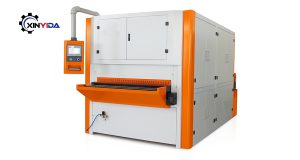In today’s fast-paced manufacturing industry, automation has become a game-changer for improving efficiency, safety, and cost-effectiveness. One area where automation is making a significant impact is deburring — the process of removing sharp edges and imperfections from machined parts. Automated deburring equipment has revolutionized the manufacturing process, enhancing safety while drastically reducing labor costs.

What is the Deburring Process?
Deburring is essential for the production of high-quality, safe machined parts. It involves removing sharp edges or burrs that result from cutting, milling, or drilling operations. These burrs can cause injuries or affect the performance and functionality of parts. While traditionally done by hand, automated deburring systems are transforming the way manufacturers handle this task.
How Automated Deburring Improves Safety in Manufacturing
- Minimizing Worker Exposure to Hazards
Traditional manual deburring can expose workers to physical risks like sharp edges, repetitive strain injuries, and exposure to harmful chemicals. Automated deburring equipment takes over these tasks, significantly reducing the risk of injuries. Machines equipped with safety sensors, emergency stops, and protective enclosures ensure that workers are safe from harm.
- Reducing Harmful Dust and Fumes
Grinding and sanding metal parts during manual deburring can release toxic dust and harmful fumes. Automated systems are designed with dust collection and filtration systems, creating a safer working environment for employees by capturing harmful particles before they spread.
- Consistent Precision for Safer Products
Inconsistent deburring can lead to uneven edges, which may cause sharp points on finished products. Automated systems ensure consistent and accurate deburring, leaving parts with safe, smooth edges and reducing the risk of injury from sharp edges.
How Automated Deburring Reduces Labor Costs
- Boosting Efficiency and Productivity
Manual deburring is time-consuming, requiring skilled labor for each part. Automated pipe deburring equipment can process multiple parts simultaneously, drastically reducing production times and labor hours. By automating the deburring process, manufacturers can increase output, reducing labor costs per unit.
- Lowering Dependence on Skilled Labor
Manual deburring requires specialized skills, but automated equipment reduces the reliance on highly skilled workers. Manufacturers can streamline their labor force by employing less specialized workers to monitor and maintain automated systems, resulting in cost savings.
- Reducing Errors and Rework
Human errors in deburring can lead to defective parts, rework, and scrap. Automated deburring systems provide precision and accuracy, reducing the risk of defects and lowering the costs associated with rework and scrap materials.
- Reducing Downtime and Maintenance Costs
Although automated deburring equipment requires regular maintenance, it typically experiences fewer breakdowns compared to manual labor operations. Fewer interruptions mean less downtime and greater overall productivity, helping to save on labor and maintenance costs.
Other Benefits of Automated Deburring Systems
- Scalability: Automated deburring equipment can handle high production volumes without additional labor costs, making it ideal for scaling manufacturing operations.
- Improved Product Quality: Automation delivers consistent, high-quality results, ensuring that parts meet rigorous safety and quality standards.
- Reduced Waste: By minimizing errors, automation reduces waste and improves material efficiency, leading to cost savings and a more sustainable manufacturing process.
Conclusion
The integration of automated deburring systems into manufacturing processes offers numerous benefits, particularly in improving safety and reducing labor costs. Automation reduces the risk of worker injuries, enhances product quality, and streamlines production, ultimately improving the bottom line. As manufacturers continue to look for ways to stay competitive, embracing automation in deburring will be crucial for improving efficiency, safety, and profitability.
